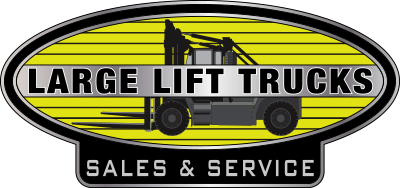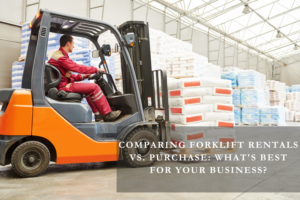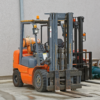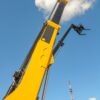Stand-Up Forklifts vs Sit-Down Forklifts: Which is Better for Industrial Applications?
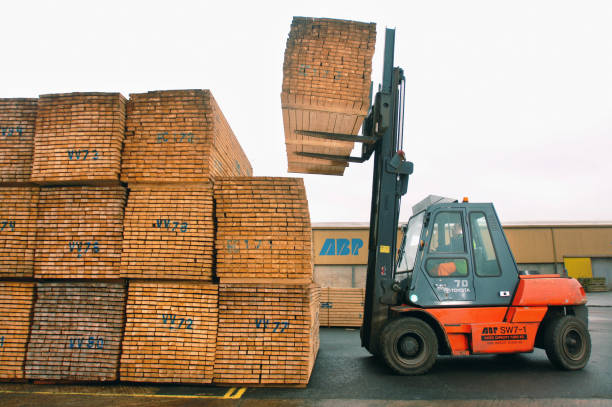
Have you ever found yourself at the crossroads of choosing between a stand-up and a sit-down forklift for your industrial operations? The decision holds significance, impacting maneuverability, operator comfort, and overall efficiency. In this article, we delve into the nuances of both types, aiming to answer the question: Which forklift best aligns with your specific operational needs? Let’s understand the complexities and guide you toward an informed choice.
Stand-Up Forklifts
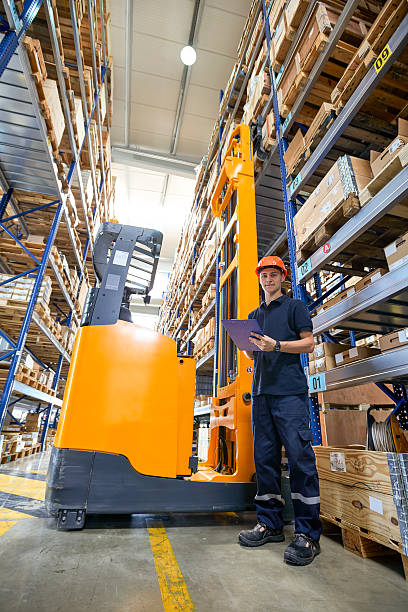
Stand-up forklifts are agile, compact machines designed for maneuvering in tight spaces, commonly used in warehouses with narrow aisles. Operators stand on a platform, ensuring a clear view of their surroundings. Ideal for tasks involving frequent stops and starts, stand-up forklifts offer versatility and efficiency in confined industrial environments.
Advantages of Stand-Up Forklifts
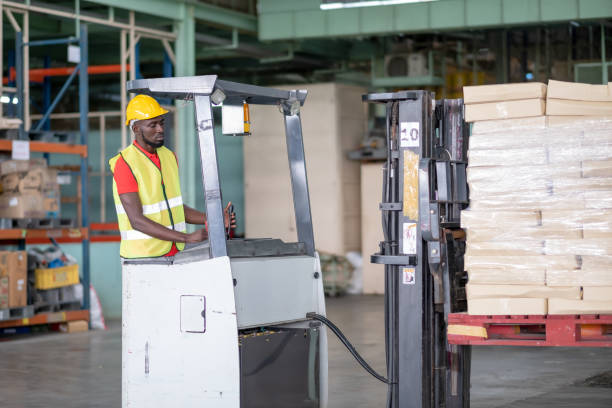
Compact Maneuverability: Stand-up forklifts shine in confined spaces, featuring a more compact design that excels in navigating through narrow aisles and tight warehouse layouts.
Quick On/Off Access: The stand-up design allows operators to easily step on and off the forklift, facilitating efficiency in tasks that involve frequent stops and starts.
360-Degree Visibility: With an elevated operator position, stand-up forklifts offer a clear 360-degree view, enhancing visibility in crowded or obstructed environments.
Ease of Entry/Exit: The absence of a cabin provides unobstructed access, making entry and exit quick and convenient for operators during their shifts.
Energy Efficiency: Stand-up forklifts are often more energy-efficient for tasks involving short distances and frequent stops due to their streamlined design.
Maneuverability in Narrow Aisles: Designed for agility, stand-up forklifts excel in warehouses with narrow aisles, contributing to efficient material handling in constrained spaces.
Cost-Effective Solution: The compact nature and simplified design of stand-up forklifts often translate to a more cost-effective solution for businesses with specific spatial constraints.
Increased Reach and Height: Stand-up forklifts often offer enhanced reach and lift capabilities, making them suitable for tasks that require stacking and retrieving goods at varying heights.
Sit-Down Forklifts
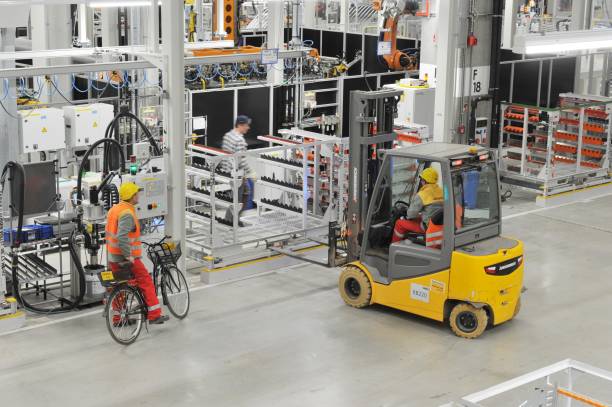
Sit-down forklifts, designed for comfort during extended operation, feature a seated cabin providing a 360-degree view. Known for stability and ideal for handling heavy loads, they are preferred for longer-distance transport and outdoor applications. These forklifts offer ease of use and are suitable for various industrial environments, providing efficiency and operator comfort.
Advantages of Sit-Down Forklifts
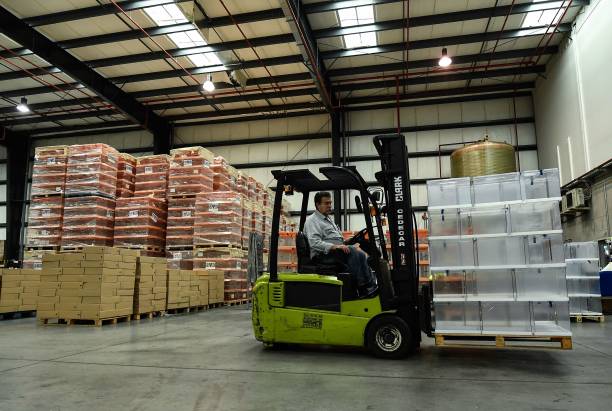
Ergonomic Operation: Sit-down forklifts offer operators a comfortable seated position, reducing fatigue during extended shifts.
360-Degree Visibility: The design of sit-down forklifts provides operators with a clear and unobstructed view, enhancing safety and efficiency.
Stability for Heavy Loads: Well-suited for handling heavy loads, sit-down forklifts prioritize stability, making them reliable for transporting substantial materials.
Versatility Across Distances: Ideal for longer distances, sit-down forklifts are proficient in navigating various terrains while maintaining operator comfort.
Adaptability to Various Applications: Sit-down forklifts are versatile and find application in diverse industrial settings, accommodating different load sizes and operational needs.
Reduced Operator Fatigue: With a comfortable seating arrangement, sit-down forklifts minimize operator fatigue, ensuring sustained productivity during demanding tasks.
Efficient Indoor Operation: Suited for indoor environments, sit-down forklifts are adept at maneuvering through confined spaces, contributing to seamless warehouse operations.
Enhanced Maneuverability: The design of sit-down forklifts allows for precise and controlled maneuvering, which is particularly beneficial in settings with limited space or intricate layouts.
See related: How to clean a forklift?
The Major Differences Between Stand-Up Forklifts and Sit-Down Forklifts
The table below highlights key distinctions in design, functionality, and application to guide you in selecting the most suitable forklift for your specific operational needs.
| Feature | Stand-Up Forklifts | Sit-Down Forklifts |
| Operator Position | Operators stand on a platform, allowing for quick on/off. It is ideal for tasks involving frequent stops, and starts, enhancing agility in narrow aisles. | Operators sit in a cabin, providing comfort during longer shifts. This seating arrangement is advantageous for tasks that involve extended periods of operation and stability. |
| Maneuverability | Stand-up forklifts excel in navigating tight spaces and narrow aisles due to their compact design. They are ideal for warehouses with limited space. | Sit-down forklifts are better suited for tasks that require traveling longer distances. Their design prioritizes stability, making them suitable for handling heavier loads. |
| Visibility | Stand-up forklifts offer a clear view of the surroundings, as the operator is unencumbered by a cabin. This enhances visibility, particularly in congested or busy environments. | Sit-down forklifts provide a 360-degree view for the operator from the cabin. This comprehensive visibility is advantageous for outdoor applications and tasks requiring precise maneuvering. |
| Load Handling | Stand-up forklifts are designed for tasks involving frequent stops and starts. They are well-suited for handling lighter loads efficiently and maneuvering in confined spaces. | Sit-down forklifts prioritize stability, making them the go-to choice for tasks involving heavier loads. Their design ensures the safe and secure handling of substantial materials. |
| Indoor/Outdoor Use | Stand-up forklifts are compact and well-suited for indoor use. Their agile design is optimized for navigating narrow warehouse aisles efficiently. | Sit-down forklifts are versatile and can be used both indoors and outdoors. Their stability and design make them suitable for various applications, accommodating diverse operational environments. |
| Energy Efficiency | Stand-up forklifts are often more energy-efficient, consuming less power during operation. This can lead to cost savings over time, especially in facilities with high usage. | The energy efficiency of sit-down forklifts depends on the specific model and usage. Some models may be optimized for efficiency, while others may prioritize power for heavy-duty applications. |
Choosing Between a Sit-Down and Stand-Up Forklift
Deciding between a sit-down and stand-up forklift is pivotal for optimizing your industrial operations. Consider the following factors to make an informed choice of forklifts tailored to your specific needs:
Workspace Assessment: Start by evaluating your warehouse layout. If navigating narrow aisles is a priority, the agility of a stand-up forklift could be beneficial.
Load Characteristics: Consider the nature of the loads you handle. For frequent stops and lighter loads, the skill of a stand-up forklift might be advantageous. For heavier loads over longer distances, a sit-down forklift’s stability is crucial.
Operator Comfort: Prioritize operator comfort, especially for longer shifts. A sit-down forklift, with its comfortable cabin, can contribute to increased efficiency and satisfaction among operators.
Visibility Needs: Assess the importance of Visibility in your operations. The elevated position of a stand-up forklift provides a clear view, making it advantageous in crowded or confined spaces.
Energy Efficiency: Consider the energy efficiency required for your tasks. Stand-up forklifts are often more energy-efficient for shorter distances and frequent stops, while sit-down models excel in longer-distance operations.
Indoor vs. Outdoor Use: Determine the primary operating environment. Stand-up forklifts are generally more suited for indoor use, while sit-down forklifts offer versatility for both indoor and outdoor applications.
Test Drive and Operator Feedback: Conduct test drives with potential operators to gather feedback on comfort, ease of use, and overall satisfaction. Operator insights are invaluable in making a decision that aligns with practical needs.
Maintenance Considerations: Factor in maintenance requirements. Evaluate the ease of maintenance for each type, as it can significantly impact the long-term cost of ownership.
Actionable Adverbs
Boasting over 40 years of industry mastery, Large Lift Trucks offers a diverse inventory featuring top brands like Hyster, Catterpillar, Toyota, and more. Our commitment extends to efficient repair services, flexible financing options, and a locally-rooted, globally accessible presence. With decades of experience, competitive pricing, and a focus on customer efficiency, we provide high-quality forklift solutions tailored to your needs at — Large Lift Trucks; where expertise meets excellence in forklifts.
Common Questions about Stand-Up Forklifts
Q1: Can stand-up forklifts operate in narrow aisles?
Yes, stand-up forklifts are designed for maneuverability in narrow aisles, making them an excellent choice for warehouses with limited space.
Q2: Are sit-down forklifts more stable than stand-up models?
Yes, sit-down forklifts are known for their stability, especially when handling heavier loads. The seated position and lower center of gravity contribute to enhanced stability.
Q3: What is the turning radius of a typical sit-down forklift?
The turning radius of sit-down forklifts can vary depending on the model and specifications. Generally, sit-down forklifts have a wider turning radius compared to stand-up models, which can impact maneuverability in confined spaces.
Q4: Are stand-up forklifts more energy-efficient than sit-down models?
Stand-up forklifts are often more energy-efficient for tasks involving shorter distances and frequent stops. However, energy efficiency depends on various factors, including the specific model and operational conditions.
Q5: Which type of forklift is more versatile for different applications?
The versatility of a forklift depends on the specific operational needs. Stand-up forklifts excel in narrow spaces, while sit-down forklifts are versatile for various applications, including outdoor use and handling heavier loads. Choosing the most versatile option depends on your specific requirements.
